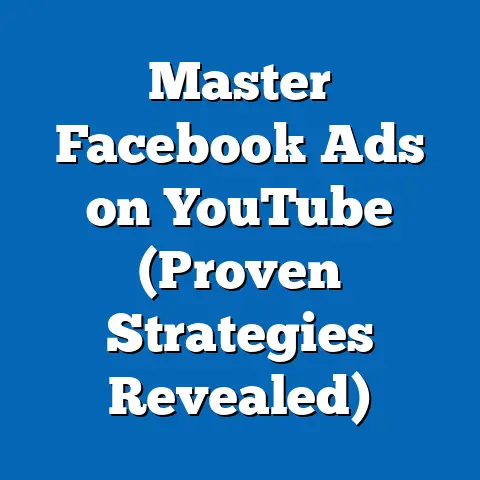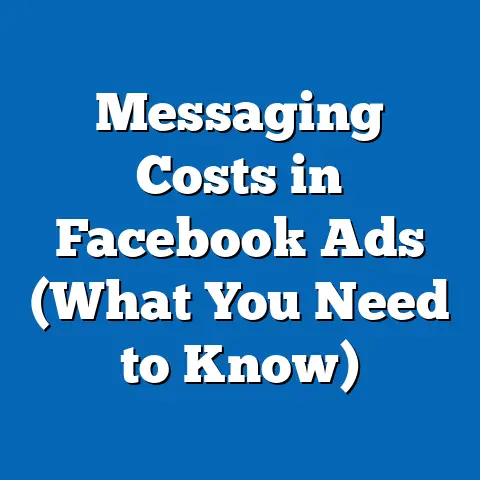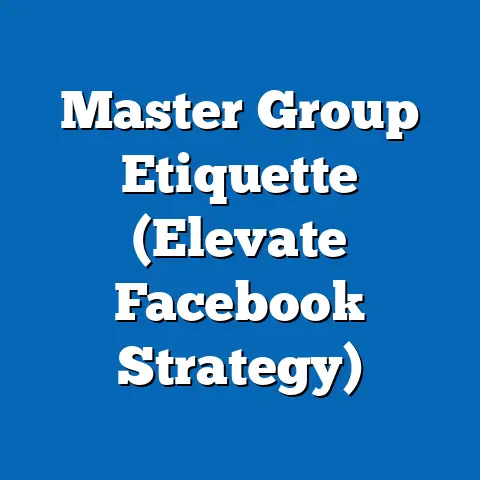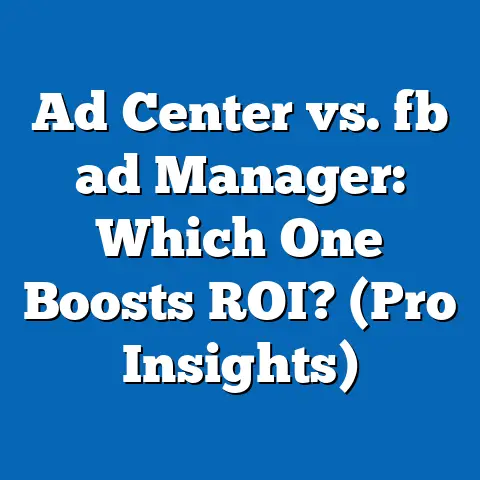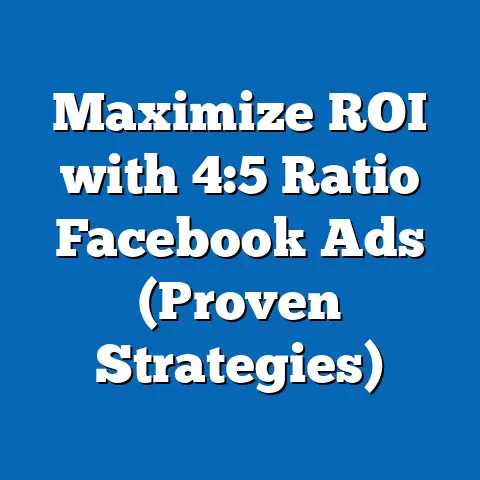Master AdRoll’s Facebook Ad Specs (Unlock Proven Strategies)
Facebook advertising has become a cornerstone of modern marketing, offering businesses of all sizes the opportunity to connect with billions of potential customers. But navigating the ever-changing landscape of ad specs and best practices can feel like trying to hit a moving target. I remember when I first started running Facebook ads – I spent hours resizing images, tweaking text, and trying to figure out why my ads weren’t performing as expected. It was a frustrating experience, to say the least.
My goal is to arm you with the knowledge and tools you need to create compelling, high-performing ads that drive engagement, conversions, and ultimately, business growth. So, let’s dive in!
Understanding Facebook Ad Specs
Facebook ad specs are the technical guidelines that dictate how your ads should appear on the platform. These specs cover everything from image dimensions and video resolutions to character limits for text and call-to-action button requirements. Adhering to these specs is not just a suggestion; it’s a necessity. If your ads don’t meet the requirements, they may be rejected or, worse, displayed incorrectly, leading to a poor user experience and wasted ad spend.
Think of it like this: you wouldn’t try to fit a square peg into a round hole, right? Similarly, you can’t expect an ad designed for Instagram to perform well on Facebook without adjusting its specifications. Facebook’s algorithm prioritizes ads that provide a seamless and engaging experience for its users, and that starts with adhering to the platform’s guidelines.
Here’s a breakdown of the different ad formats available on Facebook and their respective specifications:
-
Image Ads: These are the simplest form of Facebook ads, featuring a single image and accompanying text.
- Image Size: Recommended resolution is 1200 x 628 pixels.
- Aspect Ratio: 1.91:1
- File Type: .JPG or .PNG
- Text Limit: Primary Text: 125 characters, Headline: 40 characters, Description: 30 characters.
- Why it’s important: Image ads are the workhorses of Facebook advertising, ideal for showcasing products, services, or brand messaging. They’re easy to create and can be highly effective when paired with compelling visuals and concise copy.
-
Video Ads: Video ads are a more engaging format, allowing you to tell a story and capture attention through motion and sound.
- Video Ratio: 1:1 (square), 4:5 (vertical), 16:9 (landscape)
- Recommended resolution: Highest resolution available that meets aspect ratio requirements.
- File Type: .MP4 or .MOV
- Video Length: Recommended to be 15 seconds or less for optimal engagement.
- Text Limit: Primary Text: 125 characters, Headline: 40 characters, Description: 30 characters.
- Why it’s important: Video ads are incredibly versatile and can be used to showcase product demos, customer testimonials, behind-the-scenes content, and more. They’re particularly effective for capturing attention in the crowded newsfeed.
-
Carousel Ads: Carousel ads allow you to display multiple images or videos in a single ad unit, each with its own headline, description, and link.
- Image Size: 1080 x 1080 pixels (square)
- Video Size: 1080 x 1080 pixels (square)
- Aspect Ratio: 1:1
- File Type: .JPG, .PNG, .MP4, or .MOV
- Text Limit: Headline: 40 characters, Description: 20 characters.
- Why it’s important: Carousel ads are perfect for showcasing multiple products, highlighting different features of a single product, or telling a story across multiple cards. They offer a more interactive experience and can drive higher engagement rates.
-
Slideshow Ads: Slideshow ads are similar to video ads but use a series of still images to create a video-like effect.
- Image Size: 1280 x 720 pixels
- Aspect Ratio: 16:9, 1:1, or 2:3
- File Type: .JPG or .PNG
- Text Limit: Primary Text: 125 characters, Headline: 40 characters, Description: 30 characters.
- Why it’s important: Slideshow ads are a cost-effective alternative to video ads, allowing you to create visually appealing content without the need for expensive video production. They’re great for showcasing a series of images or highlighting different aspects of your brand.
-
Collection Ads: Collection ads are designed for e-commerce businesses, allowing you to showcase a catalog of products in a visually appealing format.
- Image Size: 1200 x 628 pixels
- Video Size: 1200 x 628 pixels
- Aspect Ratio: 1:1
- File Type: .JPG, .PNG, .MP4, or .MOV
- Text Limit: Primary Text: 125 characters, Headline: 40 characters, Description: 30 characters.
- Why it’s important: Collection ads offer a seamless shopping experience, allowing users to browse products directly from the Facebook newsfeed. They’re particularly effective for driving sales and increasing revenue for e-commerce businesses.
Image Ads: These are the simplest form of Facebook ads, featuring a single image and accompanying text.
- Image Size: Recommended resolution is 1200 x 628 pixels.
- Aspect Ratio: 1.91:1
- File Type: .JPG or .PNG
- Text Limit: Primary Text: 125 characters, Headline: 40 characters, Description: 30 characters.
- Why it’s important: Image ads are the workhorses of Facebook advertising, ideal for showcasing products, services, or brand messaging. They’re easy to create and can be highly effective when paired with compelling visuals and concise copy.
Video Ads: Video ads are a more engaging format, allowing you to tell a story and capture attention through motion and sound.
- Video Ratio: 1:1 (square), 4:5 (vertical), 16:9 (landscape)
- Recommended resolution: Highest resolution available that meets aspect ratio requirements.
- File Type: .MP4 or .MOV
- Video Length: Recommended to be 15 seconds or less for optimal engagement.
- Text Limit: Primary Text: 125 characters, Headline: 40 characters, Description: 30 characters.
- Why it’s important: Video ads are incredibly versatile and can be used to showcase product demos, customer testimonials, behind-the-scenes content, and more. They’re particularly effective for capturing attention in the crowded newsfeed.
Carousel Ads: Carousel ads allow you to display multiple images or videos in a single ad unit, each with its own headline, description, and link.
- Image Size: 1080 x 1080 pixels (square)
- Video Size: 1080 x 1080 pixels (square)
- Aspect Ratio: 1:1
- File Type: .JPG, .PNG, .MP4, or .MOV
- Text Limit: Headline: 40 characters, Description: 20 characters.
- Why it’s important: Carousel ads are perfect for showcasing multiple products, highlighting different features of a single product, or telling a story across multiple cards. They offer a more interactive experience and can drive higher engagement rates.
Slideshow Ads: Slideshow ads are similar to video ads but use a series of still images to create a video-like effect.
- Image Size: 1280 x 720 pixels
- Aspect Ratio: 16:9, 1:1, or 2:3
- File Type: .JPG or .PNG
- Text Limit: Primary Text: 125 characters, Headline: 40 characters, Description: 30 characters.
- Why it’s important: Slideshow ads are a cost-effective alternative to video ads, allowing you to create visually appealing content without the need for expensive video production. They’re great for showcasing a series of images or highlighting different aspects of your brand.
Collection Ads: Collection ads are designed for e-commerce businesses, allowing you to showcase a catalog of products in a visually appealing format.
- Image Size: 1200 x 628 pixels
- Video Size: 1200 x 628 pixels
- Aspect Ratio: 1:1
- File Type: .JPG, .PNG, .MP4, or .MOV
- Text Limit: Primary Text: 125 characters, Headline: 40 characters, Description: 30 characters.
- Why it’s important: Collection ads offer a seamless shopping experience, allowing users to browse products directly from the Facebook newsfeed. They’re particularly effective for driving sales and increasing revenue for e-commerce businesses.
It’s important to note that Facebook’s ad specs are subject to change, so it’s crucial to stay updated with the latest guidelines. One thing I’ve learned over the years is that adaptability is key in the world of digital marketing. As of October 2023, Facebook has made some minor adjustments to text limits and video specifications, so be sure to double-check the official Facebook Ads Guide for the most up-to-date information.
Takeaway: Understanding and adhering to Facebook ad specs is fundamental for creating effective ads. By knowing the specific requirements for each ad format, you can ensure your ads are displayed correctly and provide a seamless user experience.
The Importance of AdRoll in Facebook Advertising
Now that we’ve covered the basics of Facebook ad specs, let’s talk about how AdRoll can help you master them. AdRoll is a leading marketing platform that specializes in helping businesses run effective advertising campaigns across multiple channels, including Facebook.
One of the biggest advantages of using AdRoll is its ability to simplify the process of creating ads that meet Facebook’s specifications. AdRoll’s user-friendly interface and automated features make it easy to resize images, optimize videos, and craft compelling ad copy that adheres to Facebook’s guidelines.
I remember when I first started using AdRoll, I was amazed at how much time it saved me. Instead of manually resizing images and tweaking text, I could simply upload my assets to AdRoll, and the platform would automatically optimize them for Facebook’s specifications. It was a game-changer!
Here’s how AdRoll simplifies Facebook advertising:
- Automated Ad Creation: AdRoll offers a range of pre-built templates and design tools that make it easy to create visually appealing ads that meet Facebook’s specifications.
- Cross-Channel Management: AdRoll allows you to manage your Facebook ad campaigns alongside your other marketing channels, such as Google Ads and email marketing, all from a single platform.
- Data-Driven Optimization: AdRoll integrates data analytics to help you understand your audience better and make data-driven decisions. The platform tracks key performance indicators (KPIs) such as click-through rates (CTR), conversion rates, and return on ad spend (ROAS), allowing you to optimize your campaigns for maximum performance.
AdRoll also provides valuable insights into your audience, helping you identify the right demographics, interests, and behaviors to target with your ads. This is crucial for ensuring your ads are seen by the people who are most likely to be interested in your products or services.
Takeaway: AdRoll simplifies the process of creating and managing Facebook ad campaigns, ensuring your ads meet Facebook’s specifications and are targeted to the right audience.
Proven Strategies for Facebook Ads with AdRoll
Now that you understand the importance of Facebook ad specs and how AdRoll can help you master them, let’s dive into some proven strategies for creating high-performing Facebook ad campaigns.
Targeting Your Audience
Audience targeting is the foundation of any successful Facebook ad campaign. If you’re not targeting the right people, your ads will be wasted on an audience that’s not interested in your products or services.
AdRoll’s targeting features allow you to identify and reach the right audience based on a variety of factors, including:
- Demographics: Target users based on age, gender, location, education, and other demographic characteristics.
- Interests: Target users based on their interests, hobbies, and passions.
- Behaviors: Target users based on their online behavior, such as their purchase history, website visits, and app usage.
- Custom Audiences: Create custom audiences based on your existing customer data, such as email lists or website visitors.
- Lookalike Audiences: Expand your reach by targeting users who are similar to your existing customers.
I’ve found that combining different targeting options can be particularly effective. For example, you could target women aged 25-35 who are interested in fashion and have recently visited your website. This level of granularity allows you to create highly targeted ads that resonate with your audience.
Takeaway: Audience targeting is crucial for Facebook ad success. Use AdRoll’s targeting features to identify and reach the right audience based on demographics, interests, behaviors, and custom data.
Creative Best Practices
Creating visually engaging ads is essential for capturing attention in the crowded Facebook newsfeed. Your ads should be eye-catching, relevant, and aligned with your brand identity.
Here are some tips for creating compelling Facebook ad creatives:
- Use High-Quality Images and Videos: Invest in professional photography and videography to create visuals that stand out.
- Keep it Simple: Avoid cluttering your ads with too much text or too many elements. Focus on a clear and concise message.
- Use Eye-Catching Colors and Fonts: Choose colors and fonts that are consistent with your brand and that grab attention.
- Include a Clear Call-to-Action: Tell users what you want them to do, whether it’s visiting your website, making a purchase, or signing up for your newsletter.
- A/B Test Your Creatives: Experiment with different images, videos, and ad copy to see what resonates best with your audience.
AdRoll makes A/B testing easy by allowing you to create multiple versions of your ads and track their performance. This is a great way to identify the most effective creatives and optimize your campaigns for maximum results.
When I’m designing Facebook ads, I always try to put myself in the shoes of my target audience. What would grab their attention? What would resonate with them? What would motivate them to take action? Answering these questions can help you create ads that are not only visually appealing but also highly effective.
Takeaway: Create visually engaging ads that are aligned with your brand and that resonate with your target audience. A/B test your creatives to identify the most effective elements and optimize your campaigns for maximum results.
Budgeting and Bidding Strategies
Budgeting and bidding are critical components of any Facebook ad campaign. You need to set a budget that’s realistic for your business and choose a bidding strategy that maximizes your return on ad spend.
Facebook offers a variety of budgeting options, including:
- Daily Budget: Set a fixed amount that you’re willing to spend each day.
- Lifetime Budget: Set a total amount that you’re willing to spend over the entire duration of your campaign.
AdRoll can help you optimize your ad spend by automatically adjusting your bids based on performance data. The platform uses machine learning algorithms to identify the most effective bidding strategies and ensure you’re getting the best possible return on your investment.
Here are some common bidding strategies:
- Cost-Per-Click (CPC): Pay each time someone clicks on your ad.
- Cost-Per-Impression (CPM): Pay for every 1,000 impressions your ad receives.
- Cost-Per-Action (CPA): Pay only when someone takes a specific action, such as making a purchase or signing up for your newsletter.
The best bidding strategy will depend on your specific goals and objectives. If you’re focused on driving traffic to your website, CPC bidding may be the best option. If you’re focused on brand awareness, CPM bidding may be more effective.
Takeaway: Set a realistic budget and choose a bidding strategy that aligns with your goals and objectives. Use AdRoll to optimize your ad spend and maximize your return on investment.
Measuring Success
Measuring the success of your Facebook ad campaigns is essential for understanding what’s working and what’s not. By tracking key performance indicators (KPIs), you can identify areas for improvement and optimize your campaigns for maximum results.
Here are some common KPIs to track:
- Click-Through Rate (CTR): The percentage of users who click on your ad after seeing it.
- Conversion Rate: The percentage of users who take a desired action, such as making a purchase or signing up for your newsletter, after clicking on your ad.
- Cost-Per-Click (CPC): The average cost you pay for each click on your ad.
- Cost-Per-Acquisition (CPA): The average cost you pay for each conversion.
- Return on Ad Spend (ROAS): The amount of revenue you generate for every dollar you spend on advertising.
AdRoll’s analytics tools provide valuable insights into your ad performance, allowing you to track these KPIs and identify areas for improvement. The platform also offers detailed reporting features that allow you to visualize your data and share it with your team.
I’ve found that regularly monitoring my KPIs and making adjustments to my campaigns based on the data is crucial for achieving long-term success with Facebook advertising. It’s a continuous process of testing, learning, and optimizing.
Takeaway: Track key performance indicators (KPIs) to measure the success of your Facebook ad campaigns. Use AdRoll’s analytics tools to gain valuable insights into your ad performance and identify areas for improvement.
Case Studies of Successful Campaigns
To illustrate the power of mastering Facebook ad specs and leveraging AdRoll, let’s take a look at a couple of case studies:
Case Study 1: E-Commerce Brand Boosts Sales with Targeted Carousel Ads
- Objective: Increase sales of a new line of summer clothing.
- Execution: The brand used AdRoll to create targeted carousel ads showcasing different items from the new collection. They targeted users aged 18-35 who were interested in fashion and had recently visited their website. The ads featured high-quality images of the clothing, compelling ad copy, and a clear call-to-action to “Shop Now.”
- Results: The campaign resulted in a 30% increase in sales of the new clothing line and a 20% increase in website traffic.
- Quote: “AdRoll made it easy to create visually appealing carousel ads that met Facebook’s specifications and resonated with our target audience. The platform’s targeting features allowed us to reach the right people with the right message, resulting in a significant boost in sales.”
Case Study 2: Local Restaurant Drives Reservations with Video Ads
- Objective: Increase reservations during the slow season.
- Execution: The restaurant used AdRoll to create video ads showcasing their delicious food and inviting atmosphere. They targeted users within a 5-mile radius of the restaurant who were interested in dining out. The ads featured high-quality video footage, compelling ad copy, and a clear call-to-action to “Book a Table.”
- Results: The campaign resulted in a 40% increase in reservations during the slow season and a 25% increase in website traffic.
- Quote: “AdRoll’s video ad capabilities allowed us to showcase our restaurant in a visually appealing way and reach a local audience that was interested in dining out. The platform’s targeting features ensured our ads were seen by the right people, resulting in a significant increase in reservations.”
These case studies demonstrate the power of mastering Facebook ad specs and leveraging AdRoll to achieve tangible business results. By following the strategies outlined in this guide, you can unlock the full potential of your Facebook advertising efforts and achieve your business goals.
Conclusion
Mastering Facebook ad specs and leveraging tools like AdRoll are essential for creating effective and high-performing ad campaigns. By understanding the specific requirements for each ad format, targeting the right audience, creating visually engaging creatives, and optimizing your budget and bidding strategies, you can unlock the full potential of your Facebook advertising efforts.
Remember, Facebook advertising is a continuous process of testing, learning, and optimizing. By regularly monitoring your KPIs and making adjustments to your campaigns based on the data, you can achieve long-term success and drive meaningful results for your business.
So, take the next step and explore AdRoll’s platform for your Facebook advertising needs. With the insights and strategies shared in this article, you’re well-equipped to optimize your campaigns, increase engagement, and achieve your business goals. Good luck!

